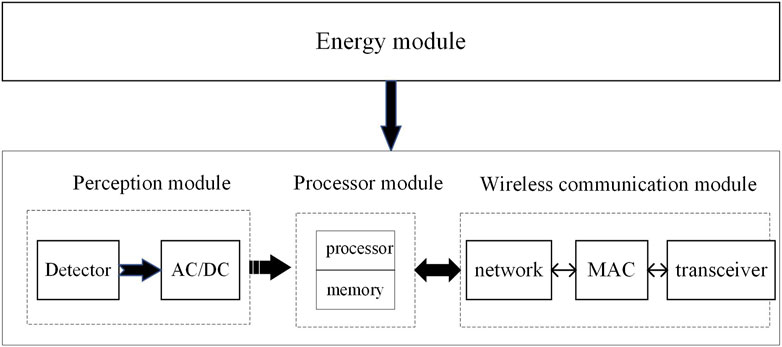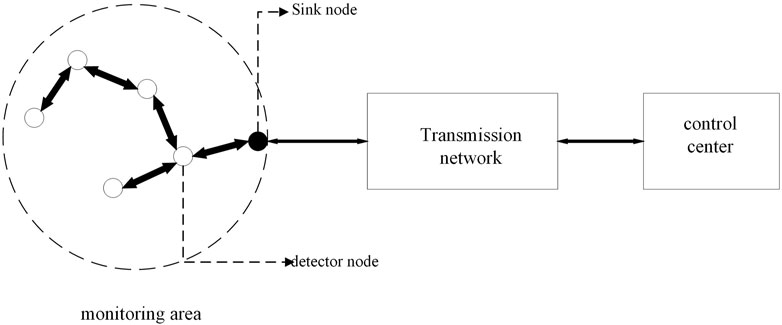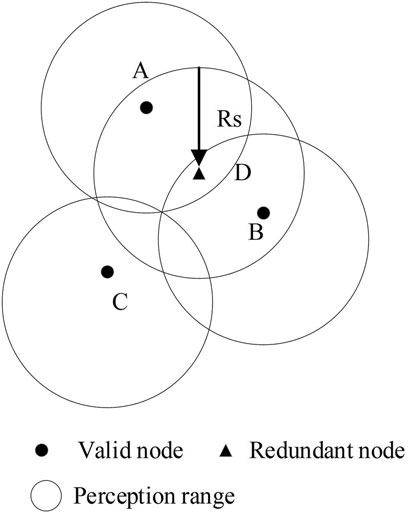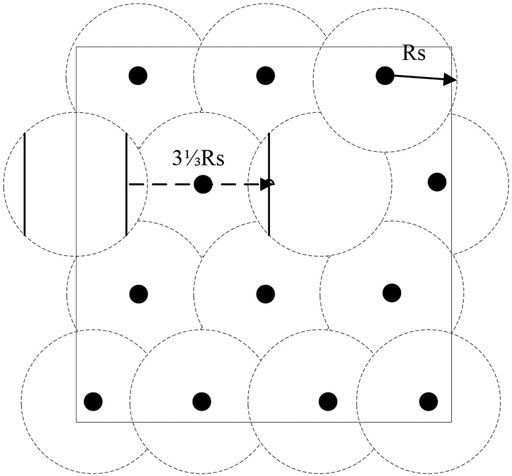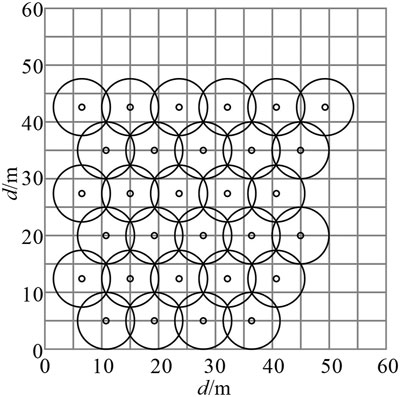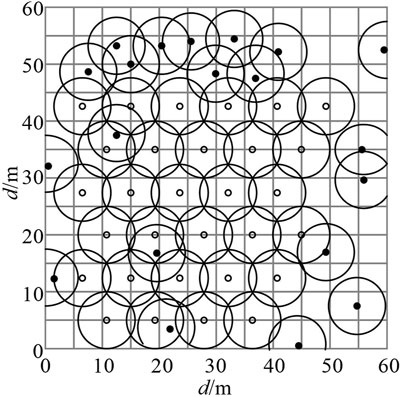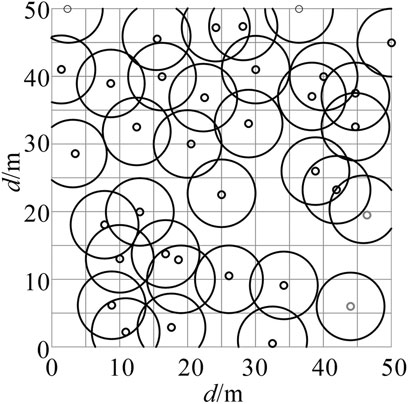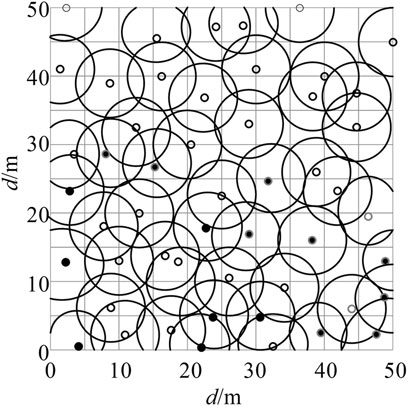- 1College of Energy and Electrical Engineering, Hohai University, Nanjing, China
- 2Jiangsu Electric Power Company Jiangyin Power Supply Company, Jiangsu, China
With the development of machine learning and image recognition technology, the detector system tends to be standardized and intelligent. However, large numbers of distributed radiation detectors connected to the power grid will bring huge uncertainty to the operation of the power grid and even cause certain interference. The monitoring system of the distributed radiation detectors can control the running status of the distributed photoelectric detection system in real-time and guarantee the safe and stable operation of the detector system. This article proposes an improved genetic detector system to avoid “blind spots” in the radiation detector monitoring based on the characteristics of photovoltaic (PV) arrays, which are considered as individual pixels, and then the reliability of the monitoring is ensured by the monitoring coverage of these pixels by the detector nodes. The performance of the radiation detector monitoring is restored by activating those spare nodes with sufficient energy to replace those that fail, ensuring that the distributed detection system can be monitored in a timely and efficient manner at all times. The simulation results confirm the reasonable validity of the algorithm.
Introduction
As the core component of modern optoelectronic systems, the photodetector has been widely used in many fields such as optical imaging, information and communication, biomedicine [1] and has also contributed to the development of military defense and national economy. With the imbalance between energy supply and demand, the contradiction between energy consumption and environmental protection is deepening, the development of an economic and environmentally friendly low-carbon power industry has become a top priority in the reform of the national power industry and a key investment area for the country, and countries around the world have reached a consensus on energy conservation and emission reduction in the formulation of future development strategies. Compared with the traditional thermal power generation, on the one hand, new energy power generation has significant advantages in environmental protection and energy-saving. On the other hand, it will also have a certain impact on the operation of the power grid. The main manifestation is that renewable new energy is affected by seasons, climate, and geography. Influenced by other factors, the intermittent, volatility, and randomness of its power generation and some of its faults will bring many problems to the safe operation of the power grid [2]. To cope with the depletion of fossil energy and reduce greenhouse gas emissions, in recent years, countries around the world have devoted themselves to research on the development and utilization of renewable energy and strive to build an energy system with new energy as the core. The development of renewable energy is also an important strategic measure for the country to solve environmental problems, optimize energy structure, promote economic and social development, and achieve energy conservation and emission reduction [3]. Therefore, the active development and utilization of solar energy, wind energy, biomass energy, and other renewable energy are of great significance in promoting the sustainable development of our country’s economy. The country’s solar energy resources are relatively sufficient, widely distributed, and evenly distributed, with unique advantages and wide application prospects [4]. Solar energy has the highest one-time conversion rate among renewable energy sources. It has a wide application area and is simple to use, clean, and pollution free, and the photovoltaic power generation system is not easily damaged, and simple maintenance is an inevitable choice for the future development of renewable energy power generation.
With the continuous decline of photovoltaic cell prices and the continuous improvement of photovoltaic power generation efficiency, the photovoltaic industry develops rapidly, and the research on the photovoltaic grid-connected power generation system has become a new research hotspot. The power generated by the photovoltaic grid-connected power generation system occupies an increasing proportion in the whole power system, which will affect the power quality of the power grid and even threaten the safe and stable operation of the power grid [5]. To meet the needs of the rapid popularization and development of distributed photovoltaic power generation systems, improve the ability of power systems to accept and control them, and ensure the reliable operation of the grid under the condition of large-scale access, the operating conditions of distributed photovoltaic power generation systems must be real-time monitoring and analysis. Based on the reasonable prediction of photovoltaic output, the coordinated dispatch between the distributed photovoltaic output and the grid can be realized, and the large-scale development of distributed photovoltaic systems can be further promoted. The radiation detector monitoring system is an important part of the photovoltaic power station, and it is a bridge connecting the photovoltaic system and monitoring center. Research on photovoltaic power generation monitoring technology will help the intelligent management of the photovoltaic power generation system and truly realize its “unmanned or few people on duty” operation management mode. In recent years, the traditional radiation detector power generation monitoring system based on computer information processing technology has been widely used. With good system scalability, low power consumption, low cost, and flexibility, the radiation detector monitoring system can collect and monitor the physical environment information in its coverage area in real-time and is increasingly used in the field of intelligent management and monitoring of systems. The emergence of distributed radiation detector monitoring technology has further promoted the development of distributed photovoltaic power generation monitoring systems [6, 7].
Compared with the traditional photovoltaic power generation monitoring system, our monitoring systems based on the distributed radiation detector technology use detector nodes to collect environmental information on the photovoltaic panel and then send it to the monitoring center through a wireless communication link [8]. Our system has the following advantages:
1) Detector nodes are small in size, low in cost, simple to deploy, and convenient to maintain. They have less environmental impact on the monitored area and avoid complicated wiring work, so they can be deployed in large numbers on photovoltaic panels.
2) The radiation detector monitoring system has the characteristics of self-system organization, which can effectively compensate for the existing wired monitoring system’s excessive dependence on lines, thereby effectively improving the monitoring level.
3) A monitoring system based on the distributed radiation detector monitoring technology consists of a large number of detector nodes, which can collect a large number of environmental information in the monitoring area. Besides, the nodes have certain computing capabilities, storage capabilities, and communication capabilities, so they can comprehensively improve the accuracy of the information collected on the photovoltaic panel. The nodes can also comprehensively improve the accuracy of information collection on the photovoltaic panel, which is beneficial to the photovoltaic power output to make accurate predictions.
4) By constructing a reasonable topology of the radiation detector system, flexibly scheduling the activity status of detector nodes, and adopting low-energy distributed radiation detector monitoring modules and wireless communication protocols, the service life of the photovoltaic power generation monitoring system can be extended and the reliability of the system can be guaranteed.
The rest of this article is organized as follows. Principle of Radiation Detector introduces the principle of the radiation detector. Architecture of Distributed Radiation Detector System introduces the distributed radiation detector system architecture. Optimization Algorithm in Distributed Radiation Detector System introduces an optimization algorithm in the distributed radiation detector system. Conclusion concludes this work.
Principle of Radiation Detector
At present, the related research results of distributed photovoltaic grid-connected power generation monitoring are mainly devoted to the research of centralized distributed photovoltaic power generation monitoring [9, 10]. An early start abroad, mainly in the 1990s, was when the system structure during this period was relatively mature [11]. The current fault diagnosis methods mainly include the visual graphics diagnosis method and multi-sensor detection method, and some scholars have proposed the ground capacitance measurement method and the time domain reflection analysis method. The visual graphics diagnosis method is used to detect the faults of different photovoltaic arrays, and the fault judgment is mainly based on the different infrared images obtained when the photovoltaic modules are taken at different operating temperatures during normal and fault conditions [12]. The fault type judged by the multi-sensor detection method is the sensor detection information, and different voltage and current sensor deployment strategies will affect the fault diagnosis result [13]. Then comes the study of online monitoring of grid-connected photovoltaic power generation systems, which not only enables real-time online monitoring of the power quality and operating status of grid-connected photovoltaic power generation but also enables comprehensive analysis and evaluation of the performance of grid-connected photovoltaic power generation systems based on a guarantee that all power quality meets certain indicators [14]. However, wired monitoring methods have inherent disadvantages of poor flexibility, while remote monitoring based on the distributed radiation detector technology has simple installation, long transmission distance, and high flexibility [15, 16]. Reference [17] designs a real-time monitoring system for solar cells based on the distributed wireless radiation detector technology. The system uses a distributed radiation detector system to form a self-organizing system of data collection modules and aggregates the collected data to the monitoring node through multi-hop routing to achieve real-time monitoring. Literature [18] studied the operation and maintenance of photovoltaic systems and IoT-based wireless detector systems for photovoltaic panel monitoring and developed and implemented a cost-effective system of wireless radiation detectors on small photovoltaic (PV) panels. In summary, the distributed photovoltaic power generation monitoring system needs to obtain monitoring information in real-time, and the photovoltaic power generation system can be controlled according to the obtained photovoltaic array operating status information, so distributed radiation detection technology is a timely and efficient monitoring method. This article considers that the photovoltaic power generation system and monitoring system of the distributed radiation detector system is composed of detector nodes with limited energy. These nodes are usually powered by batteries with limited energy, which are difficult to replace or recharge during use and will eventually fail due to exhaustion. Therefore, for distributed photovoltaic power generation systems based on the distributed radiation detector technology, ensuring that the normal operation of the system does not fail has become the primary challenge task of the important target set of the monitoring system. In Reference 19, to solve the coverage problem of directional sensor systems, a particle swarm optimization algorithm to maximize regional coverage was proposed.
Literature [20] used the simulated annealing algorithm to restore the coverage of the monitoring system. Reference 21 studied the coverage model of the system recovery mechanism and its optimal maintenance frequency. Literature [22] proposed a low-power, cost-effective photovoltaic-distributed generation (PV-DG) wireless remote monitoring system using Zigbee technology. But in these studies, when there is a problem in the monitoring system, it is more or less necessary to rebuild the system structure to achieve the purpose of restoring system performance. Some researchers have proposed to use redundant nodes to solve the problem in the visual radiation detector system [23, 24]. This article considers taking automatic recovery measures to restore various functions of the monitoring system when it fails. To ensure the effectiveness of the monitoring system, some backup nodes are added when deploying the node system. When some nodes in the monitoring system have excessive energy consumption or are exhausted, the redundant nodes are used to replace those failed nodes, and the redundant nodes in the system are fully and reasonably scheduled to achieve a stable state within a short time after the failure of some nodes in the monitoring system. This article proposes for the first time a genetic algorithm that considers random weights. The improved genetic algorithm maintains the coverage of the monitoring system by replacing failed nodes with redundant nodes and stabilizes and restores the performance of the monitoring system. The monitoring system conditions when the photovoltaic array fails are studied, and different photovoltaic arrays are collected for simulation analysis. The simulation results verify the effectiveness of the proposed algorithm.
Architecture of Distributed Radiation Detector System
In this section, we first present the structure of the wireless monitoring system and its coverage model to pave the way for the following research.
Distributed Radiation Detector System Architecture
The radiation detector system in this paper is a distributed system composed of a large number of sensor nodes with wireless communication ability, which can automatically and systematically complete the assigned tasks according to the external environment. There are a number of detector nodes deployed in the distributed radiation detector system, and its structure contains the following modules: energy module, perception module, wireless communication module, and processor module, as shown in Figure 1 [25].
Since it is difficult for sensor nodes to complete the monitoring task independently, using the WSN technology to achieve a comprehensive detection of the target area requires the cooperation of many neighbor nodes [26].
The distributed radiation detector system generally consists of the following four parts: the ordinary detector node, the sink node (Sink node), the transmission system, and the monitoring center. The structure is shown in Figure 2.
The distributed photovoltaic power generation monitoring system is constructed by a radiation detector system. To meet the requirements of the distributed photovoltaic power generation system for monitoring system accuracy, reliability, and ease of maintenance, the topology of a distributed photovoltaic power generation monitoring system based on the distributed radiation detection technology is proposed to be a hierarchical clustering topology. The monitoring system consists of M sensor nodes deployed on photovoltaic panels, s sink nodes, and 1 monitoring center. The M sensor nodes are divided into n clusters. The ordinary sensor nodes first transfer the collected physical information of the photovoltaic system to the cluster head node, and then the cluster head node transmits it to the sink node of the sink node layer. Each sink node is responsible for gathering the information of K cluster head nodes and then transmitting it to the monitoring center after preliminary processing. Finally, the monitoring center analyzes and judges the physical information of the photovoltaic system and determines the output power of the distributed photovoltaic power generation system. Make reasonable predictions and issue control commands to guide the optimal dispatch of the power grid.
Perception and Coverage Model
Coverage is one of the most important research directions in detector systems [27]. The coverage problem is to ensure that the monitoring target is covered by at least one or more detector nodes. The coverage problem is to monitor the target through the optimal deployment of detector nodes or activation of effective scheduling [28]. The coverage ratio is the ratio of the total area covered by the detector node to the total area of the required monitoring area. To calculate the coverage rate of the distributed radiation detection monitoring system, combined with the shape characteristics of the photovoltaic array (i.e., the photovoltaic array usually has a square shape), gridding the monitoring area can reduce the calculation difficulty. In this article, the monitoring area in the photovoltaic array is regarded as an m × n rectangular grid, and the grid is regarded as pixels. The detector node’s perception of the photovoltaic array in the monitoring system is equivalent to the node’s perception of the corresponding pixels. Therefore, it is very important to establish the perception model of detector nodes to measure the coverage, as shown in formula (1), considering the constraints of the perception radius Rp, signal perception attenuation rate, and possible obstacles, and establish a perception model of the monitoring area V (x, y) based on the node
where
The perception degree of all effective nodes in the photovoltaic array to the monitoring area V is as follows:
where a>b and the perception is considered effective.
The coverage model of the photovoltaic power generation wireless monitoring system is given by the following formula (4):
Node Deployment of Distributed Radiation Detector System
To ensure the performance of the photovoltaic power generation detection system, some redundant nodes are generally added to the photovoltaic array. The redundant node is different from the normal node. When all normal nodes in the system are working normally, the redundant node is in a sleep state. For the convenience of analysis, it is considered that the dormant node does not consume energy. When a node failure occurs in the system, the redundant node is activated in time to replace the failed node to continue working, ensuring the normal operation of the system. Under normal circumstances, the sensing range of an ordinary node at least needs to be covered by one or more spare nodes, as shown in Figure 3.
In the figure, Rs represents the perception radius of an ordinary node and a circular area with its radius as the perception area of the node; the sensing area of node D is covered by A, B, and C, so node D is a redundant node. To ensure the stability of the monitoring system, the coverage rate of the system must be in a high range and maintained stably, which requires us to make a certain optimization design for the deployment of redundant nodes, so the following assumptions are made:
1) After a failed node occurs in the monitoring system, the number of remaining valid nodes in the system is P, and the number of redundant nodes that are awakened to participate in the restoration of the monitoring system coverage is Q, s represents the node-set
2) The perception radius of the node is half of the communication radius,that is,
3) Assume that the coverage rate of the monitoring system is
Snc is the area not covered by the monitoring system, which can be equivalent to a d
When a failed node suddenly appears in the monitoring system, the constraints of the coverage auto-recovery model in the monitoring system in this case are as in formulas (5–8), which is denoted as follows:
An Optimization Algorithm for Redundant Node Coverage of Distributed Radiation Detector System
The redundant node deployed in the photovoltaic power generation monitoring system can quickly restore the monitoring range of the monitoring system through activation after a failed node in the system, thereby improving the stability of the monitoring system. In this article, a genetic algorithm is used with formula (4) as the objective function for optimization. The algorithm can continuously screen out the bad individuals as the population evolves from generation to generation, thus ultimately determining the best location for the deployment of nodes in the monitoring system.
The Principle of Genetic Algorithm
Genetic algorithm (GA) is a parallel random search optimal method first proposed by John Holland of the University of Michigan in 1962, and it was formally published in 1975 [29]. The genetic algorithm is a highly parallel and adaptive detection algorithm developed by imitating the evolutionary theory of nature. The genetic algorithm preserves the genetic characteristics of high adaptability to the environment by simulating individual organisms and distinguishes the information of individual genetic changes and eliminates the genetic characteristics of low adaptability to the environment to achieve the purpose of optimization. Genetic algorithms can perform global optimization in the data space, and it is highly convergent. In the genetic algorithm, the n-dimensional decision vector
where Χn represents the location of the sensor node, including the location information of all valid nodes.
The genetic algorithm first needs to have an optimized objective function value, for each individual to be able to determine its fitness in continuous development according to certain rules. In this method, the selection probability of each individual is proportional to its fitness value, and the fitness of an individual is associated with the value of the objective function of its corresponding individual phenotype X. The closer the X is to the optimal point of the objective function, the greater its fitness. Suppose the population size is x, where the fitness of individual i is
After calculating the selection probability of each individual in the population, to select the mating individual, multiple rounds of selection are required. A uniform random number between (0,1) is generated in each round, and this random number is used as a selection pointer to determine the selected individual. The basic genetic algorithm runs as a typical iteration with the following work and basic steps that must be completed:
1) Select the coding strategy to transform the parameter set space into the coded individual space, that is, the number of effective nodes in the monitoring system is converted into the number of new effective nodes after the redundant node is activated after the sensor node fails.
2) Define the fitness function according to actual problems.
3) Determine the genetic strategy and determine the probability of selection.
4) Random initialization to generate an initialization group, that is, to put all the redundant nodes in a dormant state at the beginning.
5) Calculate the fitness of the individual encoding string of the current population after decoding, that is, when some nodes fail, the fitness of other sensor nodes and redundant nodes except these failed nodes.
6) According to the genetic algorithm, use selection to act on the population to form the next generation population.
7) Determine whether the population performance is a certain index or the predetermined number of iterations has been completed to meet the best output individual, that is, when the final monitoring system reaches a stable state after the redundant node is activated, the coverage rate of the system reaches the target of the predetermined coverage model, and find out the optimal deployment strategy for activating the redundant node when the failure of node occurs.
Monitoring System Automatic Recovery Coverage Algorithm Flow
In the actual application process, not all the backup nodes equipped in the power generation array have high energy. If the energy of the backup nodes that will be activated after a failed node is also at a low value, monitoring cannot be guaranteed at this time. The system has reached a stable state after self-recovery. Therefore, to prevent the redundant node with lower energy from being activated during self-recovery, formula (11) gives relevant constraints to ensure that the redundant node with insufficient energy will not be activated.
Besides, due to the characteristics of various PV arrays, the number of failed nodes varies greatly from one PV array to another, and for this reason, the number of spare nodes needs to be limited, that is, as in formula (12), which is denoted as follows:
Based on an improved genetic algorithm with formula (4) as the objective function, the algorithm procedure is as follows:
1) Convert the monitoring area of the photovoltaic power generation system into coded individual space.
2) Define the fitness function according to the objective function.
3) The random initialization dimension is twice the sum of the dimension of all valid nodes and the alternate node value.
4) Calculate the fitness of the new monitoring area after the failure occurs.
5) According to the genetic strategy, apply the selection to the new monitoring area and rank the updated individual extreme values by the objective function value. Good individuals will replace poor individuals and update a new generation of the population.
6) Judge whether the coverage of the new monitoring area meets the specified index and end if it does. When the value of the objective function increases by
Optimization Algorithm in Distributed Radiation Detector System
A square area is established in Matlab to represent the area for monitoring photovoltaic arrays. Different types of photovoltaic arrays have different sizes, so they have different values. Let the node perception radius
Photovoltaic Monitoring System Has Failed Nodes
Since distributed photovoltaics are scattered in various places, the failures of different distributed photovoltaic arrays are different. The effectiveness of the proposed algorithm has not been verified, and the distribution of node failures is also different. In all simulation diagrams in this article, “o” represents the remaining valid nodes in the monitoring system and “•” represents the active redundant node in the monitoring system.
Regular Failure
In a photovoltaic array with a specification of 60 m × 60 m, assuming that 30 effective nodes are remaining in the monitoring system, the coverage of the monitoring system at this time is shown in Figure 5. The failure of the monitoring system caused by the damage caused by the harsh external environment and human factors is called the regular failure at this time. In this case, a part of the monitoring “blind area” will appear in the monitoring system, which is the blank area in the upper right corner of the figure. According to formulas (1–3), the coverage rate of the surveillance system is 48.23%.
Regardless of the occurrence of node failures, the monitoring system deploys new nodes in the system to rebuild the system structure and makes the following assumption: If the coverage of the restored monitoring system can be increased by 50% based on the failure, it is said to monitor the system’s return to normal performance. And i = 4.95,
To increase the coverage of the monitoring system, an improved genetic algorithm is adopted. The simulation results are shown in Figure 6.
When 35 iterations ended, it took 180.69 s. At this time, the coverage rate reached 73.51%. After calculation, the coverage rate increased by 52.41%, meeting the requirements of monitoring system recovery.
Irregular Failure Occurs
In a photovoltaic array with a specification of 50 m × 50 m, assuming that there are 35 effective nodes remaining in the monitoring system, the coverage of the monitoring system at this time is shown in Figure 7. According to formulas (1–3), the coverage rate of the monitoring system is 52.46%.
For the irregular failure situation, suppose i = 4.12,
Taking the improved genetic algorithm, the simulation results are shown in Figure 8. For 40 iterations, it took 150.37 s, at which point the coverage reached 79.53%, and the calculation shows that the coverage improved by 51.60%, meeting the requirements for restoring the performance of the monitoring system.
Time to Resume Monitoring System Performance
All algorithms in this article were run on a computer with a processing frequency of 3.20 GHz, and the simulations of the experiments were done on the Matlab platform. The case of irregular failure is more typical and represents the general occurrence of node failure. Researching the running times of different algorithms for the case of occurrence of irregularity failures, as shown in Table 1, it can be obtained that the improved genetic algorithm has the shortest computation time for both the particle swarm algorithm (PSO) and the standard genetic algorithm.
Running the above algorithm 50 times and combining the running times of the three methods and the recovery of the coverage of the surveillance system gives the data in Table 2. The results show that the improved genetic algorithm recovers the coverage of the surveillance system in the shortest time.
Conclusion
This article focuses on the situation that the distributed radiation detector monitoring system may have sensor node failure to ensure comprehensive and timely system monitoring by restoring the monitoring system coverage so that the safe and stable operation of the power grid is guaranteed. The solution is developed by deploying a number of redundant nodes in the monitoring system and by activating and reasonably scheduling the redundant nodes in the event of a failed node, thereby restoring the monitoring range of the monitoring system. To improve the coverage of the distributed radiation detector monitoring system, an improved genetic algorithm optimization method is proposed in this article. To verify that this algorithm is reasonable and effective, simulation analysis is done for different failure situations on different PV arrays. The results show that the improved genetic algorithm can quickly identify the optimal location to activate the redundant node, replace the failed node with the redundant node in time, improve the coverage of the distributed PV wireless monitoring system, and achieve the purpose of automatic recovery performance of the monitoring system.
In future studies, conditional risk values and other methods can be used to evaluate the risk of false wake nodes. With the development of optimization algorithms, new optimization algorithms can be used to further improve the accuracy of monitoring.
Data Availability Statement
The original contributions presented in the study are included in the article/Supplementary Material; further inquiries can be directed to the corresponding author.
Author Contributions
All authors listed have made a substantial, direct, and intellectual contribution to the work and approved it for publication.
Conflict of Interest
CW was employed by Jiangsu Electric Power Company Jiangyin Power Supply Company.
The remaining authors declare that the research was conducted in the absence of any commercial or financial relationships that could be construed as a potential conflict of interest.
Publisher’s Note
All claims expressed in this article are solely those of the authors and do not necessarily represent those of their affiliated organizations, or those of the publisher, the editors and the reviewers. Any product that may be evaluated in this article, or claim that may be made by its manufacturer, is not guaranteed or endorsed by the publisher.
References
1. Atabaki AH, Moazeni S, Pavanello F, Gevorgyan H, Notaros J, Alloatti L, et al. Integrating Photonics with Silicon Nanoelectronics for the Next Generation of Systems on a Chip. Nature (2018) 556(7701):349–54. doi:10.1038/s41586-018-0028-z
2. Yael P, Sovacool Benjamin K. Electricity Market Design for the Prosumer Era. Nat Energ (2016) 1(4):16032. doi:10.1038/nenergy.2016.32
4. Chen W, Ai X, Wu T. Influence of Grid-Connected Photovoltaic System on Power System. Electric Power Automation Equipment (2013) 33(2):26–32. doi:10.3969/j.issn.1006-6047
5. Sun X, Fan T, An S, Zhang Q, Zhang B. An Improved Grid-Connected Photovoltaic Power Generation System with Low Harmonic Current in Full Power Ranges. In: IEEE International Power Electronics and Application Conference and Exposition, Shanghai, China, November 2014 (2014). p. 423–8. doi:10.1109/peac.2014.7037893
6. Cai D, Zhu D. Research and Simulation of Energy Efficient Protocol for Wireless Sensor System. In: IEEE International Conference on Computer Engineering and Technology, Quanzhou, P.R. China, January 2010 (2010). p. 600–4. doi:10.1109/ICCET.2010.5485941
7. Wang Y, Jia S, Bo Z, Yan L Solar PV Module Monitoring System Based on Wireless Sensor Systems. Comput Meas Control (2014) 22(1):36–8. doi:10.16526/j.cnki.11-4762/tp.2014.01.027
8. Martín E, López A, Francisco J, Molina MG. Implementation of Wireless Remote Monitoring and Control of Solar Photovoltaic (PV)System. In: IEEE Transmission and Distribution Conference and Exposition, Latina America, September 2012 (2012). p. 1–6. doi:10.1109/TDC-LA.2012.6319050
9. Lambruschini P, Raggio M, Bajpai R, Sharma A. Supervision Analysis and Control System of Photovoltaic Power Plants. In: 2012 7th International Conference on System of Systems Engineering(SoSE 2012), Genova, Italy, July 2012 (2012). p. 1–4. doi:10.1109/sysose.2012.6384173
10. Zhang X, Chen R, Wang C, Xinlong Z. Design of Remote Monitoring and Control System center of Photovoltaic Power Station. In: IEEE Innovative Smart Grid Technologies(ISGT Asia 2014), Tianjin, China, May 2012 (2014). p. 1–3. doi:10.1109/isgt-asia.2012.6303281
11. Liu S, Dougal RA, Solodovnik EV. Design of Autonomous Photovoltaic Power Plant for Telecommunication Relay Station. IEE Proc Gener Transm Distrib (2005) 152(6):745–54. doi:10.1049/ip-gtd:20045028
12. Quarter PB, Grimaccia F, Leva S, Mussetta M, Aghaei M. Light Unmanned Aerial Vehicles(UAVs) for Cooperative Inspection of PV Plants. IEEE J Photovoltaics (2014) 4(4):1107–13. doi:10.1109/JPHOTOV.2014.2323714
13. Hu Y, Chen H, Xu R, Li R. Photovoltaic (PV) Array Fault Diagnosis Strategy Based on Optimal Sensor Placement. Proc CSEE (2011) 31(33):19–30. doi:10.13334/j.0258-8013.pcsee.2011.33.004
14. Zhou N, Yuan C, Wang Q, Dong Y, Guan R, Liu Y, et al. On-line Monitoring and State Evaluation System for Grid-Connected PV Generation Station. Electric Power Automation Equipment (2012) 32(10):6–11.
15. Lorenzo C, Loredana C, Marco F, Lazzaroni M, Rossi M. Design and Implementation of a On-Board Device for Photovoltaic Panels Monitoring. In: 2013 IEEE International Instrumentation and Measurement Technology Conference(12MTC), Minneapolis, MN, USA, May 2013 (2013). p. 1599–604. doi:10.1109/I2MTC.2013.6555684
16. Fateh B, Govindarasu M, Ajjarapu V. Wireless Network Design for Transmission Line Monitoring in Smart Grid. IEEE Trans Smart Grid (2013) 4(2):1076–86. doi:10.1109/TSG.2013.2241796
17. Liang J, Chen X. Solar Cell Monitoring System Based on Wireless Sensor System. Electric Power Automation Equipment (2010) 9 (30).
18. Sarkar S, Rao KU, Bhargav J, Sheshaprasad S, Sharma C A A. IoT Based Wireless Sensor Network (WSN) for Condition Monitoring of Low Power Rooftop PV Panels. In: IEEE 4th International Conference on Condition Assessment Techniques in Electrical Systems(CATCON) (2019). p. 1–5. doi:10.1109/CATCON47128.2019.CN004
19. Song P, Xiong Y, Wu M, She J. A New Method of Deploying Nodes for Area Coverage Rate Maximization in Directional Sensor System. In: 43rd Annual Conference of the IEEE Industrial Electronics Society, Beijing, China, November 2017 (2017). p. 8452–7. doi:10.1109/iecon.2017.8217484
20. Habib SJ, Marimuthu PN. A Coverage Restoration Scheme for Wireless Sensor Systems within Simulated Annealing. In: International Conference on Wireless and Optical Communications Systems, Colombo, Sri Lanka, September 2010 (2010). p. 1–5. doi:10.1109/wocn.2010.5587355
21. Platis AN, Drosakis EG. Coverage Modeling and Optimal Maintenance Frequency of an Automated Restoration Mechanism. IEEE Trans Reliability (2009) 58(3):470–5. doi:10.1109/tr.2009.2026777
22. Costa D, Silva I, Guedes L, Vasques F, Portugal P. Availability Issues in Wireless Visual Sensor Networks. Sensors (2014) 14(2):2795–821. doi:10.3390/s140202795
23. Costa DG, Silva I, Guedes LA, Portugal P, Vasques F. Selecting Redundant Nodes when Addressing Availability in Wireless Visual Sensor Networks. In: Proceedings of IEEE International Conference on Industrial Informatics, Porbo Alegre, Brazil, November 2014 (2014). p. 130–5. doi:10.1109/indin.2014.6945496
24. Daniel G. Costa a, Francisco Vasques B, Paulo Portugal. Enhancing the Availability of Wireless Visual Seneor Systems: Selecting Redundant Nodes in Systems with Occlusion. Appl Math Model (2017) 42:223–43. doi:10.1016/j.apm.2016.10.008
25. Potdar V, Sharif A, Chang E Wireless Sensor Systems: a Survey. Comput Syst (2003) 38(4):393–422. doi:10.1109/WAINA.2009.192
26. Zhang S. Wireless Sensor System Technology and Application. Beijing, China: China Electric Power Press (2010). p. 210–3.
27. Hirani PK, Singh M. A Survey on Coverage Problem in Wireless Sensor System. Int J Comput Appl (2015) 116(2):1–3.
28. Bao X, Han L, He X, Tan W, Fan T. Optimizing Maximum Monitoring Frequency and Guaranteeing Target Coverage and Connectivity in Energy Harvesting Wireless Sensor Networks. Mobile Inf Syst (2019) 2019(7):1–14. doi:10.1155/2019/6312589
Keywords: distributed radiation detector 分布式粒子探测器, Imaging, high resolution 高分辨率3, Photodevice, radiation detector monitoring 粒子探测器监视器5
Citation: Shao H, Wang C, Fu Z and Liu Z (2021) High-Resolution Distributed Radiation Detector System Assisted by Intelligent Image Recognition. Front. Phys. 9:693838. doi: 10.3389/fphy.2021.693838
Received: 16 April 2021; Accepted: 03 August 2021;
Published: 28 October 2021.
Edited by:
He Zhu, University of Technology Sydney, AustraliaReviewed by:
Ming Zhang, Southeast University, ChinaRunpeng Gao, Nanjing University, China
Yang Gao, Shanghai Jiao Tong University, China
Copyright © 2021 Shao, Wang, Fu and Liu. This is an open-access article distributed under the terms of the Creative Commons Attribution License (CC BY). The use, distribution or reproduction in other forums is permitted, provided the original author(s) and the copyright owner(s) are credited and that the original publication in this journal is cited, in accordance with accepted academic practice. No use, distribution or reproduction is permitted which does not comply with these terms.
*Correspondence: Hong Shao, MjAyMTAxMjRAMTYzLmNvbQ==
 Hong Shao
Hong Shao Chenyue Wang2
Chenyue Wang2 Zhixin Fu
Zhixin Fu